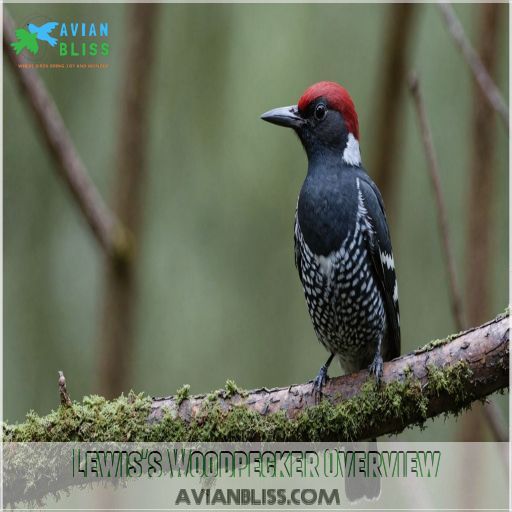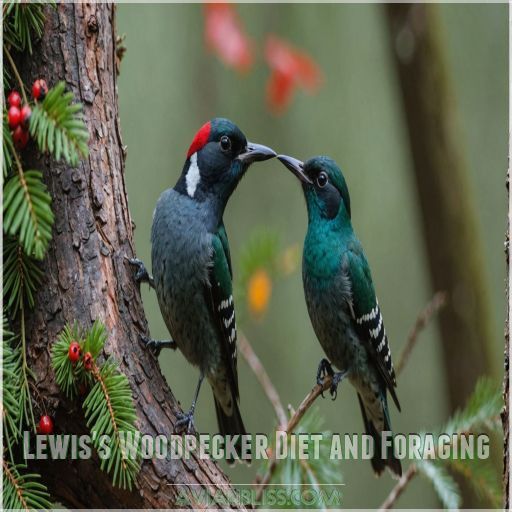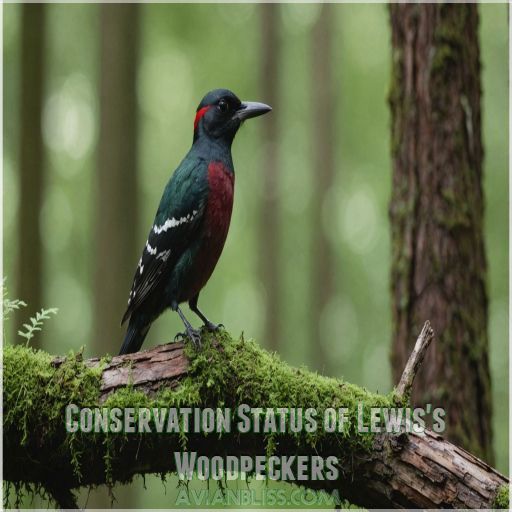This site is supported by our readers. We may earn a commission, at no cost to you, if you purchase through links.

These birds are free spirits, eschewing strict territories for a more laid-back lifestyle. They’re nature’s hoarders, stashing acorns for winter snacks.
But life isn’t all smooth sailing for these aerial daredevils – they’re facing some tough challenges. Want to know how these unique birds are adapting to a changing world and what makes them truly one-of-a-kind? There’s more to their story than meets the eye.
Table Of Contents
- Key Takeaways
- Lewis’s Woodpecker Overview
- Physical Description of Lewis’s Woodpeckers
- Habitat and Distribution of Lewis’s Woodpeckers
- Lewis’s Woodpecker Diet and Foraging
- Breeding and Nesting Behavior
- Migration Patterns of Lewis’s Woodpeckers
- Conservation Status of Lewis’s Woodpeckers
- Interaction With Humans and Other Animals
- Interesting Facts and Behaviors
- Threats to Lewis’s Woodpecker Populations
- Frequently Asked Questions (FAQs)
- What is a Lewis’s woodpecker?
- What does a Lewis’s woodpecker look like?
- What is Lewis’s woodpecker – Melanerpes lewis?
- How did Lewis describe a black woodpecker?
- Are Lewis’s woodpeckers rare?
- Where do Lewis’s woodpeckers live?
- Do Lewis woodpeckers migrate?
- Who is Lewis’s woodpecker named after?
- How do Lewiss woodpeckers differ from other woodpecker species?
- What role do Lewiss woodpeckers play in forest ecosystems?
- How can landowners help protect Lewiss woodpecker populations?
- Are there any specific laws protecting Lewiss woodpeckers?
- What research is being done on Lewiss woodpecker populations?
- Conclusion
Key Takeaways
- You’ll be amazed by this feathered rebel’s unique traits – it has a punk rocker look with a pink belly and a green-black back, and it catches insects mid-air like a winged acrobat, rather than drilling into trees like its woodpecker cousins.
- These birds are nature’s hoarders – they’ll stash acorns for winter snacks faster than you can say "squirrel." However, don’t be fooled by their prep skills; they’re facing tough times due to habitat loss and climate change.
- You can spot these avian nomads in open forests and burned areas across western North America. They’re partial migrants, so some stick around all year while others head south when the weather turns chilly – they’re quite indecisive travelers.
- If you want to be a woodpecker superhero, leave those dead trees standing in your yard – they’re prime real estate for Lewis’s woodpeckers. While you’re at it, ditch the pesticides and plant some ponderosa pines; your feathered friends will thank you.
Lewis’s Woodpecker Overview
Known scientifically as Melanerpes Lewis, this fascinating bird is named after Meriwether Lewis from the Lewis and Clark expedition.
You’re in for a treat as you discover its unique oily-green back and red face, along with its delightful foraging antics that make this woodpecker a real high-flying insect catcher and an occasional backyard bouncer!
Scientific Name – Melanerpes Lewis
When you come across the Lewis’s Woodpecker, it’s like meeting a bird with attitude.
Known scientifically as Melanerpes lewis, this woodpecker stands out with its striking plumage and unconventional habits.
Here’s the lowdown: It belongs to the order Piciformes, it thrives in open woodlands, and conservation efforts focus on habitat protection and fire suppression like those used in Vermont
.
Named After Meriwether Lewis
Let’s take a look at some history!
Lewis’s woodpecker isn’t just any bird; it’s named after Meriwether Lewis of the famous Lewis and Clark Expedition.
A legacy etched in feathers, this bird honors Lewis, who first described it in 1805.
It’s fascinating how a species connects people to history and exploration .
Physical Characteristics and Distinctions
Named for explorer Meriwether Lewis, Lewis’s Woodpecker is strikingly handsome.
This larger woodpecker flaunts a glossy green-blue-black back, an eye-catching red face, and a charming pinkish-red belly.
Its broad wings and unique flight pattern—more like a crow than a typical woodpecker bring grace to its aerial displays.
Juveniles, with their subtle red caps, sport a different kind of charm.
Vocalizations and Behavior Patterns
Lewis’s Woodpecker captivates with its vocal variety and quirky behavior.
Picture its courtship displays with flirty drumming patterns and playful social interactions.
Nesting calls and alarm signals reveal a cautious and clever side, while its unique interactions provide endless fascination.
Who knew a woodpecker could be so clever? Its lively patterns make it a true character of the forest. (Source)
Conservation Status
Although the Lewis’s Woodpecker’s population has declined over the years, conservation efforts are underway to protect this unique bird.
By restoring its preferred habitats, like open pine forests and burned areas , we can help make sure this species continues to thrive.
However, challenges like climate change and habitat loss remain . With your help, we can monitor and support this remarkable woodpecker.
Physical Description of Lewis’s Woodpeckers
You’ll be amazed by the distinct appearance of Lewis’s Woodpecker, with its colorful plumage and crow-like size that make it a standout among its peers.
Picture a woodpecker with an oily-green back, a flashy red face, and a pink belly, flaunting its unique style as it soars with wide, buoyant wings.
Size and Body Shape
Picture an athlete of the woodpecker world: Lewis’s Woodpecker is hefty yet streamlined, boasting a wingspan of 19.3-20.5 inches . Its body proportions include an elongated shape and long tail, perfect for aerial feats.
- Slim, woodpecker-like bill.
- Large body, enabling robust flight.
- Medium-sized head for balance and control.
Color Patterns – Back, Face, Belly, and Collar
When you spot Lewis’s Woodpecker, you’re in for a colorful surprise.
This bird’s got a snazzy get-up of colors: a sleek dark green back, a vibrant red face, a soft pink belly, and a distinguished gray collar.
These unique hues make it a standout among woodpeckers, reflecting a fascinating evolution of coloration , with its distinctive appearance being a key factor, and this is largely due to its vibrant red face.
Juvenile Appearance
Spotting juvenile Lewis’s Woodpeckers can be tricky! Unlike adults, these youngsters sport an overall dark look, with brownish-black backs and a subtle, missing charm: no pink belly or red face.
With such subdued juvenile coloration, they might give you a run for your money trying to tell them apart from adults.
- Less vibrant color
- Lacks red face
- No silver neck
- Darker back
- Identification challenges aplenty
Wing Shape and Flight Patterns
Imagine a Lewis’s Woodpecker gliding with the grace of a ballet dancer across the sky.
Its wing shape, perfect for aerial foraging, gives it a buoyant, soaring flight that sets it apart.
Unlike many woodpeckers, its flight isn’t interrupted by the typical flap-glide pattern; it’s a streamlined, direct journey that showcases its unique flight adaptations.
Comparison to Other Woodpeckers
Lewis’s Woodpecker stands out among its relatives. It’s not your typical woodpecker with rapid drumming and tree-hopping.
- Flight Patterns: It glides like a crow, a real enigma in woodpecker families .
- Feeding Methods: Catches insects mid-air instead of drilling into trees .
- Social Structure: Less territorial, embracing communal habitats.
Who wouldn’t admire such a rebel?
Habitat and Distribution of Lewis’s Woodpeckers
The Lewis’s woodpecker is found across a wide range in North America, from the Pacific Northwest to the Rocky Mountains and beyond.
These versatile birds thrive in diverse habitats, including open forests, woodlands, and even human-altered landscapes like orchards and parks.
Geographic Range – North America
You’re exploring the vast range of Lewis’s Woodpecker, a charismatic traveler across North America. From Montana‘s open pine forests to Arizona‘s oak woodlands, these birds are true adventurers.
| Region | Season | Occurrence |
|---|---|---|
| Montana | Summer | Common |
| Arizona | Winter | Occasionally |
| Oregon | Year-Round | Consistent |
Their distribution keeps everyone guessing, doesn’t it?
Preferred Habitats – Forests, Woodlands, and Open Country
Explore where the resilient Lewis’s Woodpecker stakes its claim. Open ponderosa pine forests, snag-dense woodlands, and oak terrains provide ideal hangouts.
Got a flair for adventure? So does this bird—it thrives in fire-adapted, human-influenced landscapes, showcasing adaptability to both natural disturbances and human presence.
It’s a real master of survival in diverse habitats.
Summer and Winter Habitats
In summer, these colorful woodpeckers thrive in burnt forests and open pine-oak woodlands, catching aerial insects like skilled trapeze artists.
As winter chills, they follow food to acorn-rich oak groves and orchards.
It’s a strategic dance between seasons, ensuring they’re never left out in the cold when survival calls the tune .
Migration Patterns
After breeding, Lewis’s Woodpeckers, like seasonal adventurers, migrate south from late August, guided by abundant food sources.
Their migration timing is unpredictable, and they prefer pathways rich in insects and nuts. Though their routes remain mysterious, these woodpeckers embrace flexibility, adjusting to environmental whims.
This adaptability highlights their resilience against climate impacts that challenge their journey.
Year-Round Populations
Lewis’s woodpeckers are true nomads, roaming far and wide year-round in search of their favorite foods.
Their year-round habitat spans open pine forests, woodlands, and even burned areas, where they can find plenty of insects, acorns, and other nuts in similar woodpecker habitats to sustain them
.
While their breeding range is limited, their wandering ways allow them to thrive across a wide swath of the western U.S. .
Lewis’s Woodpecker Diet and Foraging
With Lewis’s Woodpeckers, food isn’t just about survival—it’s about aerial acrobatics and strategic storage.
You’ll find them swooping mid-air for insects, gathering acorns and nuts in the fall, and even making an appearance at your backyard feeder with a bold attitude.
Aerial Foraging and Insect Catching
Adventure awaits as you explore the aerial hunting techniques of Lewis’s Woodpecker.
Like a daredevil flycatcher in a circus of wings, it snatches insects mid-air with acrobatic flair from high foraging perches.
This bird’s flight patterns rival the free spirit of your wildest dreams, swooping down gracefully, then ascending with a flourish.
Types of Insects Consumed
Picture a superhero of the skies, snatching insect prey types like a flycatcher in midair.
Lewis’s Woodpecker feasts on a variety of bugs, skillfully adapting to seasonal diet shifts.
This bird’s aerial acrobatics mirror a dancer’s grace, perfectly timed with insect abundance trends.
The clever shifts in its feeding habits are as dynamic as its striking plumage.
Fall Food Storage – Acorns and Nuts
Imagine enjoying a hearty fall feast; Lewis’s Woodpecker does just that by mastering the art of storing acorns and nuts.
This bird cleverly caches these treats in tree crevices, ensuring a bountiful winter pantry.
While rival birds might attempt a heist, this woodpecker defends its stash with fervor, securing its winter survival.
Importance of Trees for Foraging
You know, trees aren’t just tall, leafy giants.
For Lewis’s Woodpecker, they’re everything: trees provide numerous benefits. Different tree types, especially cottonwoods and pine, hide numerous insects.
Acorn storage in tree crevices provides winter meals. This storage is especially useful during the harsh winter months.
Best foraging height helps spot insects with eagle-like precision. This precision is crucial for the woodpecker’s survival.
Dead trees or snags, full of critters, are like woodpecker buffets waiting to happen.
Visitation to Backyard Feeders
When pondering backyard feeder visits, Lewis’s Woodpecker isn’t your everyday guest.
They’re aerial foragers, akin to acrobats performing high-wire acts for insects.
Still, if you aim to attract Lewises, stock acorns and nuts—they like a buffet—though expect some feeder aggression and food competition due to their penchant for their favorite treats.
Craft your feeder design wisely to prevent neighborhood quarrels over their favorite treats (Source).
Breeding and Nesting Behavior
Lewis’s woodpeckers are skilled cavity nesters, excavating their homes high up in trees.
From courtship displays to parental care, these fascinating birds have a complex breeding cycle that helps their young thrive in the wild.
Excavation of Cavity Nests
Though not a traditional carpenter, Lewis’s Woodpecker expertly chooses nest sites with soft wood for easier excavation [Citation:4]. Both sexes work together, crafting a snug cavity that’s just right in depth and entrance size. This clever choice shields their young from predators and highlights their preference for trees offering both protection and a panoramic aerial view—a real estate agent’s dream! [Citation:4].
Nest Height and Location
Lewis’s Woodpeckers aren’t just picky about their partners; they’re particular about their nests too.
Nest height varies dramatically—they’re as comfortable at chest level as they’re scaling over 100 feet.
Preferring coniferous and decaying trees, they use existing cavities, occasionally remodeling like a woodpecker with a hardhat.
Despite human impact, tree choice remains unchanged, indicating a strong preference for their natural nesting sites, a characteristic that can be described as a woodpecker with a hardhat .
Pair Bonding and Courtship
Courtship rituals of the Lewis’s Woodpecker kick off with aerial acrobatics and charming displays. Nest site selection becomes a duet of decision-making, as pairs reinforce their bond through synchronized movements and quirky calls.
- Mating displays strengthen pair bonding.
- Territorial defense secures nesting spots.
- Pair bonding duration promotes cooperation.
It’s nature’s own love story on wings.
Nesting Season and Duration
During nesting season, you can bet it’s a well-orchestrated event!
Nest site selection usually favors decaying trees, and they’ll use natural cavities or enlarge existing ones to fit a clutch size of 5-9 eggs.
With an incubation period of 12-16 days, you’ve got a pretty dedicated parents-to-be!
Parental Care and Chicks
Imagine this: both parents are tirelessly feeding their nestlings, ensuring each one in the small brood gets its fill.
Together, they share the parental duties, like dedicated dance partners, balancing chick feeding and nestling development.
Success? It hinges on their teamwork, turning fledglings into self-sufficient woodpeckers ready to soar into the world.
Migration Patterns of Lewis’s Woodpeckers
You might be surprised to learn that Lewis’s Woodpeckers aren’t your typical migratory birds.
They set off on partial, short-distance, and altitudinal migrations based on the season’s whims.
Their journeys aren’t just about flying south but involve clever strategies to adapt to changing climates and food supplies, proving that even woodpeckers have a flair for adventure!
Partial Migration
As a Lewis’s woodpecker, you’re a partial migrant – some of your kind stick around all year, while others take to the skies in late summer or early fall.
This flexibility helps you adapt to changing food sources and habitat conditions across your range.
Your migration is likely triggered by a mix of seasonal cues:
- Declining insect populations
- Availability of acorns and nuts for winter storage
- Changing day length and temperatures
Short-Distance Migration
After breeding, you’ve got short-distance migrators like Lewis’s Woodpecker finding their wintering spots closer by. Think of it as a commute rather than a grand tour.
Factors like food availability and local weather are the migration triggers and help determine timing variations.
| Aspect | Breeding Grounds |
|---|---|
| Migration Routes | Opportunistic and Local |
| Wintering Grounds | Nearby Suitable Habitats |
It’s nature’s way of keeping options open.
Altitudinal Migration
When Lewis’s Woodpeckers set out on their short-distance journeys, they’ve got a knack for seeking higher elevations, where thinned air and sprawling views offer a survival edge.
It’s like nature’s way of saying, "Change your altitude, change your attitude!"
Timing their altitudinal migrations after breeding, these woodpeckers chase food sources, ensuring survival amidst changing landscapes and seasons.
Factors Influencing Migration
Altitude changes may seem dizzying, but they help Lewis’s Woodpecker dodge challenges like unpredictable food supplies and fickle weather patterns.
Imagine these woodpeckers as savvy travelers, adjusting their routes based on survival essentials like food availability, climate change, and habitat shifts.
Think of it as their version of a strategic retreat to boost breeding success and evade predator pressure .
Migration Routes
You’re probably wondering how Lewis’s Woodpeckers decide where to go.
Their migration patterns aren’t set in stone; they’re like nature’s drifters, chasing abundant food and favorable environments.
Imagine them as avian road-trippers, heading to wintering grounds in the south, with route variations depending on environmental factors.
These adaptable birds make the journey from breeding grounds almost like a dance with nature.
Conservation Status of Lewis’s Woodpeckers
You’re about to discover why Lewis’s Woodpeckers are causing quite a flutter in the conservation world.
With populations declining faster than your missing socks, understanding the threats they face is important.
From climate change to habitat loss.
Declining Population Trends
Even with their graceful flights, Lewis’s Woodpeckers face declining population trends.
They’ve been dancing with challenges like:
- Habitat loss due to fire suppression
- Food scarcity amidst sprawling developments
- Pesticide use impacting insect availability
- Climate change altering habitat conditions
- Disease outbreaks threatening health
These woodpeckers are struggling to keep their homes in snags and their meals in sight.
Threats – Climate Change, Habitat Loss, and Insect Decline
As a Lewis’s woodpecker, you face a triple threat – climate change, habitat loss, and declining insect populations.
Warming temperatures disrupt your migration patterns, while deforestation and fire suppression destroy your nesting grounds. With fewer bugs to feast on, your survival hangs in the balance.
But don’t lose hope – conservation efforts can help restore your forest home.
| Threat | Impact | Solution |
|---|---|---|
| Climate Change | Disrupted migration, altered habitat | Habitat restoration, climate-smart forestry |
| Habitat Loss | Fewer nesting sites, reduced food sources | Protect old-growth forests, manage wildfires |
| Insect Decline | Food scarcity, reduced breeding success | Promote biodiversity, reduce pesticide use |
Conservation Efforts and Recommendations
Lewis’s Woodpeckers face habitat loss and climate challenges, but there’s hope in conservation!
- Habitat restoration: Maintain open oak and ponderosa pine woodlands.
- Population monitoring: Engage in citizen science projects.
- Forest management: Preserve old, decaying trees they nest in.
- Community involvement: Spread awareness and protect local environments.
Your actions can give these unique birds a fighting chance!
Partners in Flight – Continental Concern Score
Tackling the Lewis’s Woodpecker’s hurdles requires knowing their Continental Concern Score of 15 out of 20, putting them on the Yellow Watch List.
Their song echoes through declining habitats, where challenges like habitat loss and climate change threaten their future.
It’s like watching a hero guard their dwindling kingdom—engage in preserving these remarkable aerial acrobats before they’re history!
Recovery Plans and Strategies
Imagine you’ve got a magic toolbox for saving birds—inside, you’ll find habitat restoration, population monitoring, and conservation partnerships ready to put to work!
Equip yourself with public education and climate adaptation strategies to champion Lewis’s Woodpecker’s comeback.
Let your enthusiasm soar as you rally support, knowing each tree saved shelters dreams of freedom and skyward adventures for these remarkable birds.
Interaction With Humans and Other Animals
You’ve probably seen Lewis’s Woodpeckers turning your backyard feeder into a lively wrestling match as they aggressively defend their territory from other birds.
These woodpeckers put on a show but also play a critical role in maintaining the balance of forest ecosystems, all while avoiding predators with their acrobatic flight.
Aggression at Backyard Feeders
You’ve got a vivid backyard oasis, teeming with life.
But with Lewis’s Woodpecker, things can get spicy!
These charismatic birds often show aggression at bird feeders, driven by food competition and their natural bird dominance.
As they guard their food sources, particularly suet or nut feeders, they stir up entertaining species conflicts, adding drama to your avian soap opera.
Territorial Behavior
When protecting their patch, Lewis’s Woodpeckers exhibit fascinating territorial behavior. Picture them engaged in spirited wing displays and vocalizations to guard their turf.
They defend several key areas, including the following:
- Nest Sites: Ensuring their future generations. Like many woodpeckers in Kansas, including the Northern Flicker and Red-headed Woodpecker, Lewis’s Woodpeckers often build their nests in tree trunks woodpeckers of kansas. This behavior helps them create a safe and stable environment for their young.
- Feeding Grounds: Storing acorns like nature’s hoarders, a common behavior among woodpeckers that forage for seeds, especially in deciduous forests and Pennsylvania woodpeckers’ habitats and urban areas
.
- Mating Grounds: With vibrant displays.
- Resource Control: Fending off competition with cunning.
These clever woodpeckers embody freedom in their fight for survival.
Social Structure and Grouping
Lewis’s woodpeckers are quite social, often forming small flocks to forage together.
They establish mating pairs and defend territories, but also engage in cooperative behaviors like group roosting.
These adaptable birds can even be spotted at backyard feeders, where they may jostle with other species for access to the tasty treats.
Interaction With Predators
Tangled in a daily dance of survival, Lewis’s Woodpecker handles predator interactions with finesse.
They employ clever defense strategies:
- Freeze and Flee: When danger looms, they freeze or outmaneuver predators like Cooper’s Hawks .
- Undercover Tactics: Hiding under branches is a favorite move.
- Evasive Flying: Swift aerial escape artists.
- Nest Defense: Guard cavities fiercely.
- Adaptive Diets: Alter diet as needed.
Impact on Forest Ecosystems
By effortlessly creating cavities, Lewis’s Woodpeckers build tiny homes for critters, promoting forest regeneration .
Their pest control prowess manages insect populations, subtly shifting the ecosystem’s balance.
Acting as a hidden maestro, they contribute to seed dispersal, assisting in forest recovery after disturbances like fire suppression.
It’s a remarkable symphony of roles, weaving life into our wild backyards.
Interesting Facts and Behaviors
You’ll be amazed by the Lewis’s Woodpecker’s unique flying style.
The bird can be spotted darting gracefully through the sky like it’s doing aerial acrobatics.
It can also be seen perched sideways on branches, defying woodpecker norms with its quirky habits and charm.
Unique Flying Patterns
Imagine spotting a Lewis’s Woodpecker in action—it’s like witnessing an avian acrobat. These woodpeckers in action—it’s like witnessing an avian acrobat!
These woodpeckers soar with grace, gliding smoothly through the air in ways that’d make other woodpeckers envious.
With their slow and direct flight, they perfect the art of swooping and circling, resembling a small crow or jay from afar.
It’s truly a performance worth a standing ovation!
Perching and Roosting Behavior
Lewis’s Woodpeckers often perch in surprising places, like perpendicular branches or wires, thanks to their unique perch adaptations.
They’re fond of roosting in hollow trees, especially at higher elevations, choosing perch heights that offer a good view.
Their roosting time varies, but they keep things lively with their acrobatic displays. Observing them is more like watching gymnast birds!
Foraging Strategies
How do Lewis’s Woodpeckers snag their meals? You’ll be amazed by their unique foraging strategies.
Unlike their tree-drilling cousins, these savvy birds prefer aerial hunting, snatching insects mid-flight . They’re also clever hoarders, stashing acorns for winter feasts.
Their diverse diet includes a buffet of flying insects, and they’ve perfected the art of flycatching in open areas. Talk about adaptable appetites!
Adaptability to Human-Altered Landscapes
You’d be amazed at how Lewis’s Woodpeckers have rolled with the punches of urbanization.
These clever birds have taken to human-altered landscapes like ducks to water. They’ve been known to set up shop in unusual spots, from earth banks to drainpipes .
It’s as if they’re saying, "If you can’t beat ’em, join ’em!" Their adaptability is a sign of nature’s resilience in the face of change, showing that they’ve learned to roll with the punches.
Unique Characteristics Among Woodpeckers
While most woodpeckers drill into trees for food, you’ll find Lewis’s Woodpeckers flycatching with the grace of a ballerina.
Their unique flight pattern, slow and direct with long glides, might remind you of a crow.
These social birds often form large flocks, unlike their solitary cousins.
They’re also known for their impressive aerial acrobatics when catching insects mid-flight, a sight that’ll leave you in awe of nature’s creativity.
Threats to Lewis’s Woodpecker Populations
You might think the vibrant Lewis’s Woodpecker has it easy, but these unique birds face a host of challenges.
From climate change to habitat loss, let’s explore the threats that are putting these aerial acrobats to the test.
Climate Change Impacts
Climate change is throwing Lewis’s Woodpeckers a curveball. As temperatures rise, these quirky birds face a host of challenges.
Their food sources are shifting, with insects emerging at different times and acorn crops becoming less reliable . You’ll notice these adaptable birds expanding their range northward and to higher elevations, seeking cooler climes (Source).
But it’s not all smooth sailing – drought impacts are hitting hard, leading to worrying population declines in some areas, which can be considered a significant climate change challenge.
Habitat Fragmentation and Loss
Habitat fragmentation and loss pack a punch for Lewis’s woodpeckers. These birds are feeling the squeeze as their once-vast ponderosa pine forests and oak woodlands become a patchwork of isolated patches . It’s like trying to play a game of musical chairs, but with fewer and fewer seats available.
- Open canopy forests are shrinking faster than you can say "woodpecker"
- Snags and dying trees, prime real estate for nesting, are disappearing
- Forest edges are increasing, exposing woodpeckers to new threats
Insect Decline and Food Scarcity
Imagine a world without the buzz of insects. For Lewis’s Woodpeckers, that’s a nightmare scenario.
You mightn’t realize it, but these birds rely heavily on insects for their daily meals.
As insect populations plummet due to various factors, our feathered friends face a dire food shortage.
This scarcity impacts their breeding success and overall population numbers, potentially leading to long-term declines if alternative food sources aren’t found or conservation strategies implemented.
Human Disturbance and Nesting Disruption
Despite their resilience, Lewis’s Woodpeckers face mounting challenges due to human activities. You’d be surprised how our actions can disrupt their nesting habits.
- Noise pollution scares away breeding pairs
- Forest management practices destroy potential nest sites
- Recreational activities disturb incubating hens
- Urban expansion fragments critical habitats
By understanding these threats, we can work together to minimize human-wildlife conflict and protect these fascinating birds. Remember, every small effort counts in conservation!
Disease and Parasites
While Lewis’s Woodpeckers face numerous threats, diseases and parasites can silently wreak havoc on their populations.
You’d be surprised to learn that these birds are susceptible to various ailments, including the Usutu virus, which has been detected in other woodpecker species.
Tick-borne diseases also pose a risk, with the spread of ticks like Haemaphysalis longicornis potentially impacting their health.
Keep an eye out for signs of illness in your local woodpecker populations.
Frequently Asked Questions (FAQs)
What is a Lewis’s woodpecker?
You’re in for a treat! A Lewis’s woodpecker isn’t your typical tree-tapper.
This unique bird flycatches like a pro, sports a striking pink belly, and loves to hoard nuts.
It’s nature’s aerial acrobat with a sweet tooth!
What does a Lewis’s woodpecker look like?
Imagine a crow-sized bird with a striking color palette: greenish-black back, silver collar, dark red face, and pinkish belly.
You’ll spot this unique woodpecker perched on bare branches, ready to snatch insects mid-air with its crowlike flight.
What is Lewis’s woodpecker – Melanerpes lewis?
Picture a bird that flies like a crow but forages like a flycatcher. That’s the Lewis’s woodpecker – Melanerpes lewis.
This unique species has a dark green back, pink belly, and gray collar, unlike any other woodpecker.
It’s a true avian rebel.
How did Lewis describe a black woodpecker?
Lewis didn’t describe a black woodpecker. You’re thinking of Lewis’s Woodpecker, named after Meriwether Lewis.
It’s not actually black, but has a dark iridescent green-black back, pink belly, and red face. Quite the colorful character!
Are Lewis’s woodpeckers rare?
You might spot one at a park, but don’t count on it.
Lewis’s woodpeckers are uncommon and declining. Their population has dropped by about 48% since
They’re threatened in Canada, with fewer than 1,000 individuals , which is a declining trend.
Where do Lewis’s woodpeckers live?
These woodpeckers call open pine forests, woodlands, and burned forests home.
They breed from southeastern British Columbia to central California and New Mexico, stretching eastward to western South Dakota.
They’re adaptable nomads, always on the move, in their open pine forests.
Do Lewis woodpeckers migrate?
Picture a feathered nomad, restless as autumn leaves.
You’ll find these avian adventurers setting off on their southward journey in late August or early September.
They’re opportunistic migrants, following abundant food sources rather than fixed routes.
Who is Lewis’s woodpecker named after?
Lewis’s Woodpecker got its name from Meriwether Lewis, one half of the famous Lewis and Clark expedition.
This unique bird, with its pink belly and green back, was discovered during their exploration of the Louisiana Purchase.
How do Lewiss woodpeckers differ from other woodpecker species?
With a striking pink belly and green back, you’ll spot these unique flyers easily.
Unlike their cousins, they catch insects mid-air like flycatchers and soar like crows.
They’re nature’s aerial acrobats, bringing flair to forests.
What role do Lewiss woodpeckers play in forest ecosystems?
You’ll find these dynamic forest architects playing a key role in shaping ecosystems.
They create important tree cavities, providing homes for various species like owls and flying squirrels.
They also control insect populations through their foraging habits.
How can landowners help protect Lewiss woodpecker populations?
Holy snags, Batman! Your forest’s about to become a woodpecker wonderland!
Preserve those dead trees like they’re gold.
Plant ponderosa pines like there’s no tomorrow, and ditch the pesticides.
You’ll be the neighborhood’s avian superhero in no time!
Are there any specific laws protecting Lewiss woodpeckers?
Yes, there are laws protecting these birds.
The Migratory Bird Treaty Act makes it illegal to remove woodpeckers, their eggs, or young from nests or scare adults away during breeding season.
This applies to Lewis’s woodpeckers too.
What research is being done on Lewiss woodpecker populations?
Recent studies focus on habitat selection, breeding success, and conservation strategies.
Researchers are comparing nest-site preferences and survival rates in different forest types, examining the impacts of early nesting, and evaluating the importance of snag retention.
Conclusion
Did you know that Lewis’s woodpeckers can fly up to 45 mph? These aerial acrobats are truly one-of-a-kind.
From their punk rock appearance to their unique foraging habits, they’ve carved out a special niche in the bird world.
As you’ve learned, Lewis’s woodpeckers face challenges, but there’s hope. By supporting conservation efforts and creating bird-friendly spaces, you can help make sure these feathered daredevils continue to grace our skies.
Keep an eye out – you might just spot a Lewis’s woodpecker on your next outdoor adventure!













